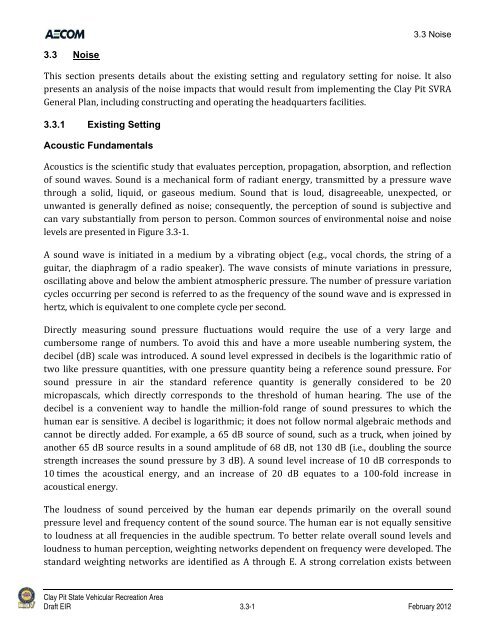Draft Environmental Impact Report - California Off Highway Vehicle ...
Draft Environmental Impact Report - California Off Highway Vehicle ...
Draft Environmental Impact Report - California Off Highway Vehicle ...
Create successful ePaper yourself
Turn your PDF publications into a flip-book with our unique Google optimized e-Paper software.
3.3 Noise<br />
3.3 Noise<br />
This section presents details about the existing setting and regulatory setting for noise. It also<br />
presents an analysis of the noise impacts that would result from implementing the Clay Pit SVRA<br />
General Plan, including constructing and operating the headquarters facilities.<br />
3.3.1 Existing Setting<br />
Acoustic Fundamentals<br />
Acoustics is the scientific study that evaluates perception, propagation, absorption, and reflection<br />
of sound waves. Sound is a mechanical form of radiant energy, transmitted by a pressure wave<br />
through a solid, liquid, or gaseous medium. Sound that is loud, disagreeable, unexpected, or<br />
unwanted is generally defined as noise; consequently, the perception of sound is subjective and<br />
can vary substantially from person to person. Common sources of environmental noise and noise<br />
levels are presented in Figure 3.3‐1.<br />
A sound wave is initiated in a medium by a vibrating object (e.g., vocal chords, the string of a<br />
guitar, the diaphragm of a radio speaker). The wave consists of minute variations in pressure,<br />
oscillating above and below the ambient atmospheric pressure. The number of pressure variation<br />
cycles occurring per second is referred to as the frequency of the sound wave and is expressed in<br />
hertz, which is equivalent to one complete cycle per second.<br />
Directly measuring sound pressure fluctuations would require the use of a very large and<br />
cumbersome range of numbers. To avoid this and have a more useable numbering system, the<br />
decibel (dB) scale was introduced. A sound level expressed in decibels is the logarithmic ratio of<br />
two like pressure quantities, with one pressure quantity being a reference sound pressure. For<br />
sound pressure in air the standard reference quantity is generally considered to be 20<br />
micropascals, which directly corresponds to the threshold of human hearing. The use of the<br />
decibel is a convenient way to handle the million‐fold range of sound pressures to which the<br />
human ear is sensitive. A decibel is logarithmic; it does not follow normal algebraic methods and<br />
cannot be directly added. For example, a 65 dB source of sound, such as a truck, when joined by<br />
another 65 dB source results in a sound amplitude of 68 dB, not 130 dB (i.e., doubling the source<br />
strength increases the sound pressure by 3 dB). A sound level increase of 10 dB corresponds to<br />
10 times the acoustical energy, and an increase of 20 dB equates to a 100‐fold increase in<br />
acoustical energy.<br />
The loudness of sound perceived by the human ear depends primarily on the overall sound<br />
pressure level and frequency content of the sound source. The human ear is not equally sensitive<br />
to loudness at all frequencies in the audible spectrum. To better relate overall sound levels and<br />
loudness to human perception, weighting networks dependent on frequency were developed. The<br />
standard weighting networks are identified as A through E. A strong correlation exists between<br />
Clay Pit State Vehicular Recreation Area<br />
<strong>Draft</strong> EIR 3.3-1 February 2012








